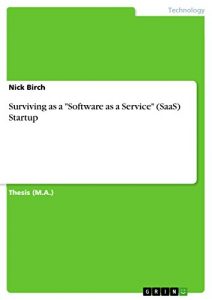Thesis (M.A.) from the year 2015 in the subject Computer Science - Software, grade: 1.6, Central Queensland University, course: Arts Administration Research, language: English, abstract: Software as a Service (SaaS) is changing the way businesses operate. It’s not just a trend: it’s a proven way for small business owners to save time and money. We owe it all to the cloud for ushering SaaS into the business world.
When examining the basics of running a business, a single subscription to a SaaS app could take the place of an entire department. Small businesses and start ups can have email, file storage, expenses, purchasing, human resources, collaboration and task management at a lower cost for IT and software. With access to services and software that was once only available to huge companies because of the high cost of infrastructures and maintenance, software services allow a business to cut costs and focus on their product and services instead of setting up elaborate software or delegating between departments.
As a startup in the SaaS space, it is a long and perilous journey just to survive, let alone be notably successful. As the marketplaces have become quickly crowded, just finding a niche deems very difficult, let alone actively dominating one. The big players easily establish themselves, offering freemium cloud storage and software build upon already successfully proven programs. Microsoft now offers its Office suite in the cloud and Google has its slew of online business tools, all as various and competitively priced monthly subscriptions. Other startups moved in quickly at the outset, snatching up software real estate and thriving: Basecamp for project management, Freshbooks for accounting, Salesforce for customer relationship management, Pinterest for project and interest discovery, Snapchat for innovative mobile conversation, the list goes on (Vidra, 2014).
So what exactly does it take to survive as a SaaS startup in today’s information age?
Technological innovation, design, strong business models and customer attraction and retention all seem to be at the forefront of SaaS culture, although the difference between short and long-term success may be more elusive than any particular set of recipes for permanence.
When examining the basics of running a business, a single subscription to a SaaS app could take the place of an entire department. Small businesses and start ups can have email, file storage, expenses, purchasing, human resources, collaboration and task management at a lower cost for IT and software. With access to services and software that was once only available to huge companies because of the high cost of infrastructures and maintenance, software services allow a business to cut costs and focus on their product and services instead of setting up elaborate software or delegating between departments.
As a startup in the SaaS space, it is a long and perilous journey just to survive, let alone be notably successful. As the marketplaces have become quickly crowded, just finding a niche deems very difficult, let alone actively dominating one. The big players easily establish themselves, offering freemium cloud storage and software build upon already successfully proven programs. Microsoft now offers its Office suite in the cloud and Google has its slew of online business tools, all as various and competitively priced monthly subscriptions. Other startups moved in quickly at the outset, snatching up software real estate and thriving: Basecamp for project management, Freshbooks for accounting, Salesforce for customer relationship management, Pinterest for project and interest discovery, Snapchat for innovative mobile conversation, the list goes on (Vidra, 2014).
So what exactly does it take to survive as a SaaS startup in today’s information age?
Technological innovation, design, strong business models and customer attraction and retention all seem to be at the forefront of SaaS culture, although the difference between short and long-term success may be more elusive than any particular set of recipes for permanence.



